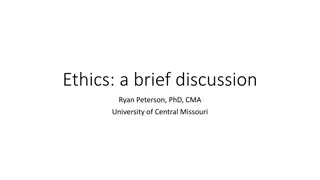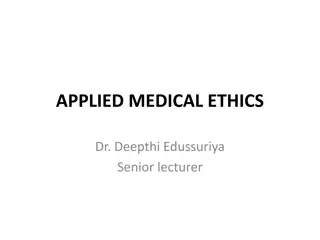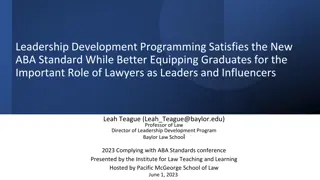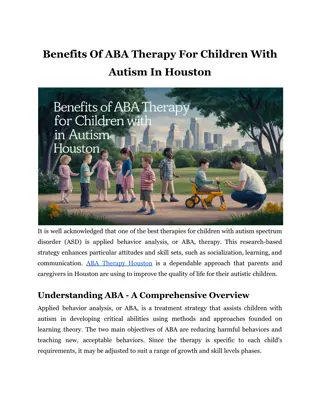Introduction to ABA, Ethics, & Core Principles: A Paradigm Overview
This chapter provides a historical context of approaches to ethical behavior in behavior analysis. It discusses theoretical conflicts, the importance of consequences, and reviews dominant paradigms in clinical ethics such as virtue ethics, consequentialism, and deontology. It explores the concept of moral excellence and how individuals can be labeled as virtuous based on their consistent and reinforced ethical behaviors.
Uploaded on Jul 29, 2024 | 11 Views
Download Presentation

Please find below an Image/Link to download the presentation.
The content on the website is provided AS IS for your information and personal use only. It may not be sold, licensed, or shared on other websites without obtaining consent from the author.If you encounter any issues during the download, it is possible that the publisher has removed the file from their server.
You are allowed to download the files provided on this website for personal or commercial use, subject to the condition that they are used lawfully. All files are the property of their respective owners.
The content on the website is provided AS IS for your information and personal use only. It may not be sold, licensed, or shared on other websites without obtaining consent from the author.
E N D
Presentation Transcript
Introduction to ABA, Ethics, & Core Principles Brodhead, Cox, and Quigley (2018)
Chapter Overview Brief historical context of approaches to distinguish right from wrong Assumptions of what is right conduct for behavior analysts Theoretical conflicts between difference claims of what is right conduct for behavior analysts Applied ethics within the science of behavior analysis is far from comprehensive and complete Awareness of historical and philosophical context can guide practitioner applications of the BACB Ethics Code (2014)
Paradigms of Clinical Ethics Providing the Groundwork
Paradigms of Clinical Ethics The science and practice of behavior analysis emphasizes the importance of consequences The importance of consequences for right behavior have been recognized for thousands of years (Hammurabi & Johns, 2008) The rules and consequences for right behavior are related to a host of variables (e.g., geographical region, cultural group, context of the act)
Paradigms of Clinical Ethics A brief review of dominant paradigms in clinical ethics Virtue Consequentialism Deontology
Paradigms of Clinical Ethics Virtue Ethics Virtue ethics argues that moral excellence, or virtue, is the proper focus or reflection on ethics and rules for behavior (e.g., Hursthouse & Pettigrove, 2016) Some behaviors are ethical, right , or good in and of themselves regardless of the context or outcomes Honesty Patience
Paradigms of Clinical Ethics Virtue Ethics Individuals may be labeled as virtuous if two conditions are met: The individual tends to emit behavior consistent with the socially agreed- upon label (e.g., honesty) The individual s virtuous response should be fluent and maintained by non- social reinforcement Example A behavior analyst repeatedly only reports the true type and amount of billable hours for reimbursement through an insurance company
Paradigms of Clinical Ethics A brief review of dominant paradigms in clinical ethics Virtue Moral excellence is the proper focus for rules of behavior Consequentialism Deontology
Paradigms of Clinical Ethics Consequentialism Consequentialism argues the outcomes of a behavior determine whether that behavior is right or wrong Act consequentialism behavior is right or wrong if and only if that act maximizes the good Hedonsim pleasure is the only right , and that pain / aversiveness are the only wrong
Paradigms of Clinical Ethics Consequentialism A consequentialist paradigm suggests a behavior is ethical if: The behavior causes the greatest happiness for the greatest number Stated another way, the behavior maximizes the good and minimizes the bad for all relevant parties Example maximizing the overall amount of reinforcers a client contacts relative to the aversive experiences needed to obtain the reinforcers. A comparison of the number of reinforcers without intervention should also be considered.
Paradigms of Clinical Ethics A brief review of dominant paradigms in clinical ethics Virtue Moral excellence is the proper focus for rules of behavior Consequentialism The outcomes of a behavior determine right or wrong Deontology
Paradigms of Clinical Ethics Deontology Deontology define right and wrong as function of the behavior and the context in which that behavior occurs The premises of deontology are based upon highlighting weaknesses of virtue and consequentialism
Paradigms of Clinical Ethics Deontology Weakness of virtue Behaviors cannot always be right or wrong . There are contexts in which virtuous behavior is right . Example Lying to your significant other about your location because you are planning a surprise party him / her
Paradigms of Clinical Ethics Deontology Weaknesses of consequentialism The consequences of our behavior are often out of our control It places impractical demands due to having to consider all potential outcomes, for all behavior, for all people It can result in extreme permissiveness; it seems to demand innocents be killed, beaten, etc. as it results in the greater benefit for others
Paradigms of Clinical Ethics Deontology Weakness of deontology The norms of behavior are often decided by people who have power of some kind (e.g., religion, government officials) Post-hoc justification of behavior; contextual factors that others may not have observed or identified are used to justify behavior
Paradigms of Clinical Ethics A brief review of dominant paradigms in clinical ethics Virtue Moral excellence is the proper focus for rules of behavior Consequentialism The outcomes of a behavior determine right or wrong Deontology The function of behavior and the context determine right or wrong
Western Clinical Code of Ethics Ethical paradigms can influence how you justify right or wrong Ethical paradigms do not inherently state what is right or wrong Formal codes of ethics guide right and wrong
Western Clinical Code of Ethics Formal codes of clinical ethics Medicine is the oldest helping profession Early writings of Hippocrates and others discussed qualities of good physicians The writings also included oaths to perform duties (e.g., benefit, no harm)
Western Clinical Code of Ethics Formal codes of clinical ethics Code of Medical Ethics (1847) Principles of Medical Ethics (1966) Respecting the rights of patients Demonstrating ongoing competency and improvement in skills Accepting and respecting the discipline of the profession Obtaining consultation when necessary Maintaining client confidentiality Being a good citizen Practicing and accepting payment only within one s medical competency
Western Clinical Code of Ethics Increasing market share through codification Ethical codes can increase public trust in a profession A profession with public trust may have an increased market share Medical practice is the dominant approach to nearly all areas of healthcare Publication and adherence to the code played a role in this market share growth Many other helping professions imitated medicine and created code of ethics
Principles of Bioethics The Material for Building
Principles of Bioethics Medical/clinical ethics are subfields of bioethics Multiple factors led to its development Advancement in medical technologies Increased interaction between distinct healthcare providers Increased focus on applied ethics There was a need to establish basic ethical principles that transcended multiple healthcare professions
Principles of Bioethics The Belmont Report A response to social reactions and problems that arose from the Tuskegee Syphilis Study Conducted by the United States Public Health Services from 1932 to 1972 About 600 men who identified as African American or Black About 2/3 of the men had syphilis No consent to participate, and arguably coercive conditions The men were not told they had the disease, not that a treatment was available
Principles of Bioethics The Belmont Report There were many disturbing and unethical facets of the Tuskegee Syphilis Study, which prompted the National Commission for the Protection of Human Subjects of Biomedical and Behavioral Research to establish guidelines for conducting ethical research The Belmont Report prescribed three basic principles Respect for persons Beneficence Justice
Principles of Bioethics The Belmont Report Respect for persons Beneficence Justice
Principles of Bioethics The Belmont Report Respect for persons Treat the individual as an independently functioning individual with a right to autonomy Each individual (or caregiver) is the most appropriate person to determine what does or does not happen to his / her body Individuals with diminished autonomy are entitled to protection Autonomy can be present in varying degrees A proxy decision-maker that makes decisions that maximize benefits and minimize harms Beneficence Justice
Principles of Bioethics The Belmont Report Respect for persons Beneficence Healthcare practitioners improve the well-being of others Do no harm or primum non nocere Maximize benefits while minimizing harm Justice
Principles of Bioethics The Belmont Report Respect for persons Beneficence Justice Benefits and costs of healthcare as a resources should be fairly or justly distributed Practical decisions have to be made regarding the benefits and costs of health care
ABA & Ethics What We Have Built So Far
ABA & Ethics The BACB Professional and Ethical Compliance Code (2014) is evolved from virtue theory, consequentialism, and deontology The Code utilizes the guiding principles of respect for persons, beneficence, and justice Combining multiple paradigms and principles into a cohesive document may complicate ethical decision-making
ABA & Ethics Virtue theory influences Consequentialism influences Deontology influences
ABA & Ethics Virtue theory influences Code 1.04 regarding truth and honest; being honest is good Other examples are 1.01, 2.13, and 9.02 Consequentialism influences Deontology influences
ABA & Ethics Virtue theory influences Consequentialism influences Code 2.09 regarding use of most-effective treatments with both long-term and short-term benefits Other examples include 2.03 and 4.08 Deontology influences
ABA & Ethics Virtue theory influences Consequentialism influences Deontology influences Code 1.05 regarding behaviors a BCBA would emit in the context of professional scientific relationships Other examples in include 2.14, 2.15, 4.02, and 4.09
ABA & Ethics Consequences of influences from multiple ethical paradigms Can create flexibility in applying and justifying behavior Can result in confusion and variability when the justified ethical behaviors are not explicitly covered by the Code Claims to what is right and wrong , justified by one paradigm, may contradict claims of right and wrong from other paradigms Two Codes might directly conflict and each is justified by different paradigms
ABA & Ethical Theory Why BCBAs Should Care
ABA & Ethical Theory The history of ethical paradigms and the difficulties created are important for two reasons Analysis of ethical behavior should occur on a daily basis as behavior analysts emit behavior on a daily basis that fits within the Code. There is a need to justify this behavior. The field of behavior analysis will benefit from BCBAs understanding how ethical paradigms inform the Code. If one paradigm increases appropriate behavior and better services, the paradigm should be emphasized
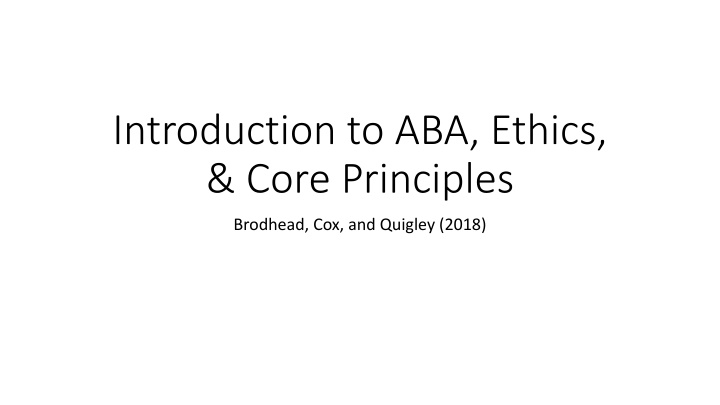

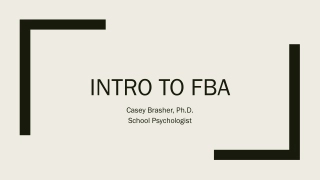
![[PDF⚡READ❤ONLINE] Black Hole Astrophysics: The Engine Paradigm (Springer Praxis](/thumb/21503/pdf-read-online-black-hole-astrophysics-the-engine-paradigm-springer-praxis.jpg)









